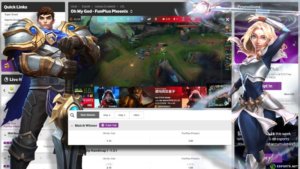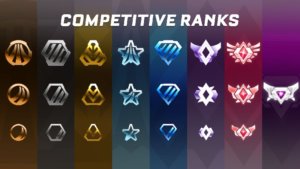The more tech-savvy people amongst us already know what a Twitch bitrate is, while others might have a faint idea or think it’s just some Twitch slang but need to know the exact details. Regardless of what knowledge of bitrates you have, as a streamer, this is one essential piece of information you must have, as it is more or less the lifeblood of your stream.
Depending on your platform of choice, our focus today will be Twitch bitrates. However, what we put out in the article can also apply to other streaming platforms, especially during multi streams.
What are Twitch Bitrates?
In layperson’s terms, bitrate refers to the number of bits per second communicated across a digital network. In technical jargon, this is the number of bits transmitted or processed per unit of time. Bits per second is the standard to indicate bit rates, and SI prefixes like kilo, mega, Giga, or Tera are terms for ascertaining the size of a bit rate.
For instance, when talking about audio file quality, you might hear something like “320kbps,” meaning an encoded audio file with a bitrate of 320 kilobits per second. The bitrate of a stream is responsible for the quality of the stream; thus, Twitch does recommend using a bit rate of about 3500 kbps – 4500 kbps for 720p streams.

© Twitch
Why is Bitrate important to Twitch Streams?
When streaming on Twitch, the bitrate of your stream is an essential factor in determining the quality of your video and audio. A higher bitrate means more data is transmitted, resulting in a higher-quality stream. However, it also means that your internet connection needs to handle the higher data transfer; otherwise, it can cause buffering and other issues.
Twitch recommends a bitrate of at least 3,500 kbps for a good-quality stream. Still, depending on your internet connection and the specifications of your computer, you can use a higher bitrate.
A higher bitrate can also make your stream more demanding on your computer, so you may need to adjust other settings like resolution and frame rate accordingly. Twitch recommends the following bitrate for 720p and 1080p streams:
- 720p (1280×720) resolution at 30 frames per second (fps): 3,500 kbps to 4,500 kbps
- 1080p (1920×1080) resolution at 30 fps: 4,500 kbps to 6,000 kbps
- 1080p (1920×1080) resolution at 60 fps: 6,000 kbps to 8,000 kbps
It’s worth noting that these are general guidelines and that the optimal bitrate for your stream may vary depending on the specific encoding settings you are using, your internet connection, and the specifications of your computer.
A higher bitrate can also make your stream more demanding on your computer, so you may need to adjust other settings like resolution and frame rate accordingly.
It’s also important to note that Twitch suggests using CBR (constant Bitrate) instead of VBR (variable Bitrate) as it allows for more consistent quality across the entire stream, especially for viewers with lower internet speeds. It’s always a good idea to play around with your bitrate settings to make sure you have the most optimal option picked for you.
Read Also: What is a good upload speed for streaming?
How to Change Twitch Bitrate Settings
As an essential tip for streaming, it’s always a good idea to go into your stream settings and tweak them to find the best Bitrate for Twitch streams for you and your viewers. Contrary to dissenting opinion, there is no best bitrate for Twitch streams, but multiple Bitrate options have different results depending on how you want your stream to look.
To change your bitrate settings on Twitch, you must use software that allows you to stream to Twitch. Here are the general steps to change your bitrate settings using Streamlabs OBS:
- Open Streamlabs OBS and log in to your Twitch account.
- Go to the “Settings” menu, and select “Output.”
- Under the “Streaming” tab, you will find the “Streaming Service” option and select Twitch.
- Under the “Video” tab, you will find the “Bitrate” option. Select the desired bitrate for your stream.
- Click on “Apply” and “OK” to save the changes.
- Start your stream as usual, and the new bitrate setting will take effect.
Read Also: How does bitrate affect video quality

Streamlabs offers up the best Twitch bitrate solutions
Conclusion
It’s also important to note that streaming software might have other ways to change the bitrate settings, but the general idea is the same: you have to look for the output settings or streaming settings and look for the bitrate option. As a streamer looking to grow on popular streaming platforms, you should always see that you can find the perfect bitrate settings to improve the quality of your Twitch streams.
Frequently Asked Questions
Can a high bitrate cause buffering on Twitch?
Yes, a high bitrate can cause buffering on Twitch if your internet connection cannot handle the increased data transfer. Thus, testing different settings is the best precautionary measure to find the best balance of quality and stability for your stream.
Will a high bitrate improve the quality of my stream?
A higher bitrate will result in a higher-quality stream. But, it also means that your internet connection needs to handle the higher data transfer, which can make your stream more demanding on your computer.
Can the bitrate affect CPU usage while streaming?
Yes, a higher bitrate can make your stream more demanding on your computer and increase CPU usage while streaming.
Can I use a variable bitrate on Twitch?
Twitch recommends using CBR (constant bitrate) instead of VBR (variable bitrate) as it allows for more consistent quality across the entire stream, especially for viewers with lower internet speeds.
Is there a maximum bitrate on Twitch?
Twitch does not have a specific maximum Bitrate, but it’s best to use a bitrate that your internet can handle without causing buffering or other issues.


















